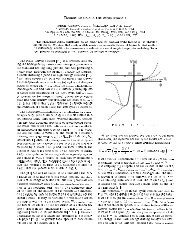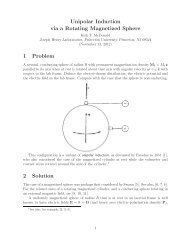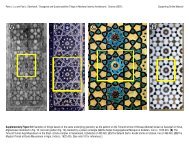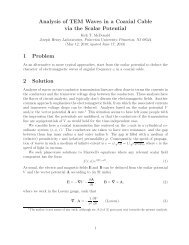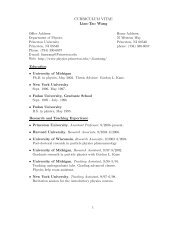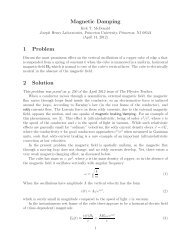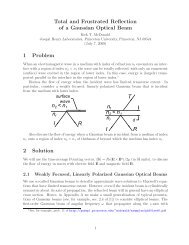Sommerfeld's Diffraction Problem - Princeton University
Sommerfeld's Diffraction Problem - Princeton University
Sommerfeld's Diffraction Problem - Princeton University
Create successful ePaper yourself
Turn your PDF publications into a flip-book with our unique Google optimized e-Paper software.
1 <strong>Problem</strong><br />
Sommerfeld’s <strong>Diffraction</strong> <strong>Problem</strong><br />
Kirk T. McDonald<br />
Joseph Henry Laboratories, <strong>Princeton</strong> <strong>University</strong>, <strong>Princeton</strong>, NJ 08544<br />
(January 22, 2012; updated April 30, 2013)<br />
Discuss the scattering (diffraction) of a plane electromagnetic wave of angular frequency ω by<br />
a perfectly conducting half plane, considering the latter to be the limit of a parabolic cylinder.<br />
Relate the results to the electromagnetic version of Babinet’s principle for complementary<br />
screens [1, 2, 3]. 1<br />
2 Solution<br />
Experiments in which polarization effects in scattering of light from a knife edge were first<br />
performed by Gouy in 1883 [7]. A partial explanation was given by Poincaré in 1892 [8].<br />
This first “complete” solution was by Sommerfeld in 1895 [9, 10], using a somewhat obscure<br />
technique. 2<br />
Here, we consider a conducting knife edge to be a limiting case of a parabolic cylinder, and<br />
take advantage of the fact that Helmholtz wave equation for a scalar wavefunction ψe −iωt ,<br />
(∇ 2 + k 2 )ψ =0, (1)<br />
where k = ω/c and c is the speed of light in vacuum, is separable in parabolic-cylindrical<br />
coordinates. Then, using an expansion of a plane wave in parabolic-cylindrical coordinates<br />
[13, 14, 15], the problem of scattering of a plane wave by a surface of constant coordinates can<br />
be given a series solution. This technique was first employed for scattering by a conducting<br />
cylinder [16], using the expansion of a plane wave in cylindrical coordinates found by Jacobi<br />
[17]. This technique can be used for surfaces of constant coordinate in the 11 coordinate<br />
systems in which the Helmholtz equation is separable [18], and permits formal solutions to<br />
a larger set of electromagnetic scattering problems than is commonly acknowledged. The<br />
example of a conducting strip as a limit of an elliptical cylinder is considered in sec. 3 of<br />
[19].<br />
The relevance of parabolic-cylindrical coordinates to the knife-edge problem was realized<br />
by Lamb [20, 21], who used them to give an alternative derivation of Sommerfeld’s solution,<br />
which alternative we follow here. 3 Other studies related to that of the present note include<br />
[22, 25, 26, 27, 28, 29, 30, 31]. See also the Appendix.<br />
The conducting screen lies in the plane y = 0 and occupies the region x>0, as shown<br />
in the figure on p. 2 (from [20]).<br />
1 A closely related problem is the diffraction of a plane electromagnetic wave by a perfectly absorbing<br />
half plane [4, 5, 6].<br />
2 This technique was characterized by Poincaré [11]as“extrémement ingéniuse.” Another early review<br />
of Sommerfeld’s method is given in [12].<br />
3 Lamb’s discussion seems little known, and is occasionally rediscovered as in [23, 24].<br />
1
In addition to ordinary cylindrical coordinates (r, φ, z), we consider parabolic-cylindrical<br />
coordinates (ξ,η,z) which are related (for 0 ≤ φ ≤ 2π) by<br />
x + iy = re iφ (ξ + iη)2<br />
= ,<br />
2<br />
x = ξ2 − η 2<br />
, y = ξη, (2)<br />
2<br />
ξ = √ 2r cos φ 2 , η = √ 2r sin φ 2 . (3)<br />
In this convention, the sign of ξ at a point (ξ,η) =(x, y) isthesameasthesignofy, while<br />
η is always non-negative. The half plane (x >0,y = 0) corresponds to η =0,andthe<br />
complementary half plane (x
2.1 Normal Incidence<br />
We first consider incident waves of the form e i(ky−ωt) , which are normally incident on the<br />
screen from y
Using the fact,<br />
we have that<br />
a u +<br />
∫ ∞<br />
0<br />
e −iζ2 dζ =<br />
√ π<br />
2 e−iπ/4 , (16)<br />
√ √ π<br />
π<br />
2 b u e −iπ/4 =0, a v −<br />
2 b v e −iπ/4 =0. (17)<br />
Finally, the condition that E z = E 0 e iky + ψ s vanish on the surface of the conducting screen<br />
implies that<br />
∫ √<br />
− E 0 = ψ s (x>0, 0) = ψ s kξ/2<br />
(ξ,0) = a u + a v +(b u + b v ) e −iζ2 dζ, (18)<br />
0<br />
and hence,<br />
Combining this with eq. (64) we find 4<br />
and<br />
ψ s = E s z = E 0<br />
( e<br />
i(ky+π/4)<br />
√ π<br />
a u + a v = −E 0 , b v = −b u . (19)<br />
a u = a v = − E 0<br />
2 , b u = −b v = E 0<br />
√ π<br />
e iπ/4 , (21)<br />
∫ √ k(ξ+η)/2<br />
0<br />
e −iζ2 dζ − e−i(ky−π/4)<br />
√ π<br />
2.1.2 Electric Field Perpendicular to the Edge<br />
∫ √ k(ξ−η)/2<br />
0<br />
e −iζ2 dζ − eiky + e −iky )<br />
.(22)<br />
2<br />
In this case the current on the conducting screen are in the x-direction, so the scattered<br />
electric field lies in the x-y plane, while both the incident and scattered magnetic field are<br />
parallel to the edge. It is therefore convenient to consider the scalar wavefunction ψ = B z =<br />
E 0 e iky + ψ s (x, y).<br />
The analysis for ψ s is similar to the preceding sec. 2.1.1, except that the boundary<br />
condition at the screen, E x (x>0, 0) = 0 implies that ∂B z (x>0, 0)/∂y =0,i.e.,<br />
∂Bz s(x>0, 0)/∂y = ∂Bs z (ξ, 0)/∂y = −ikE 0.<br />
4 In view of eq. (20), and recalling that the sign of ξ is taken to be the same as that of y, wehavethat<br />
∫ √ √<br />
ψ s (x, −y) = a u e −iky + a v e iky + b u e −iky k(−ξ+η)/2<br />
∫ − k(ξ+η)/2<br />
e −iζ2 dζ + b v e iky e −iζ2 dζ<br />
0<br />
∫ k(ξ−η)/2<br />
∫ √<br />
= a v e −iky + a u e iky + b v e −iky e −iζ2 dζ + b u e iky k(ξ+η)/2<br />
e −iζ2 dζ<br />
0<br />
= ψ s (x, y). (20)<br />
That is, ψ s = E s z satisfies the symmetry (6), as expected.<br />
0<br />
0<br />
4
To perform the derivative of the integrals in eq. (14) we need the relations<br />
Using these, we find<br />
∂ψ s (x>0, 0)<br />
∂y<br />
and hence,<br />
∂ξ<br />
∂x = ξ 2r ,<br />
∂ξ<br />
∂y = η 2r ,<br />
= −ikE 0 = ik(a u − a v )+(b u − b v )<br />
Combining this with eq. (64) we find 5<br />
and<br />
ψ s = B s z = E 0<br />
(<br />
e<br />
i(ky+π/4)<br />
√ π<br />
∂η<br />
∂x = − η 2r , (23)<br />
∂η<br />
∂y = ξ 2r . (24)<br />
(<br />
ik<br />
∫ √ kξ/2<br />
0<br />
e −iζ2 dζ +<br />
√ )<br />
k<br />
2ξ e−i√ kξ 2 /2<br />
, (25)<br />
a u − a v = −E 0 , b u = b v . (26)<br />
a u = −a v = − E 0<br />
2 , b u = b v = E 0<br />
√ π<br />
e iπ/4 , (28)<br />
∫ √ k(ξ+η)/2<br />
0<br />
e −iζ2 dζ + e−i(ky−π/4)<br />
√ π<br />
∫ √ k(ξ−η)/2<br />
2.1.3 Asymptotic Behavior near the Geometric Shadow<br />
0<br />
e −iζ2 dζ − eiky − e −iky )<br />
.(29)<br />
2<br />
To exhibit the well-known behavior of the fields near the edge of the geometric shadow (first<br />
deduced by Fresnel in a scalar theory), it is convenient to recast the integrals in eqs. (22)<br />
and (29) as running from ζ to ∞,<br />
ψ s<br />
∫<br />
= − ei(ky+π/4) ∞<br />
∫<br />
√ √ e −iζ2 dζ ± e−i(ky−π/4) ∞<br />
√ √ e −iζ2 dζ ∓ e −iky . (30)<br />
E 0 π k(ξ+η)/2 π k(ξ−η)/2<br />
We consider these waves for large y = ξη ≈ ξ 2 ≈ η 2 and small x =(ξ 2 − η 2 )/2 ≈ (ξ − η)/ √ y,<br />
where the total wavefunction ψ = E 0 e iky + ψ s has the form<br />
∫<br />
ψ<br />
≈± e−i(ky−π/4) ∞√kx ∫<br />
√ e −iζ2 dζ + e iky ∓ e −iky ≈± e−i(ky−π/4) ∞√kx<br />
√ e −iζ2 dζ, (31)<br />
E 0 π 2 /y<br />
π 2 /y<br />
5 In view of eq. (28), and recalling that the sign of ξ is taken to be the same as that of y, wehavethat<br />
∫ √<br />
ψ s (x, −y) = a u e −iky + a v e iky + b u e −iky k(−ξ+η)/2<br />
∫<br />
√<br />
− k(ξ+η)/2<br />
e −iζ2 dζ + b v e iky e −iζ2 dζ<br />
0<br />
∫ √<br />
= −a v e −iky − a u e iky − b v e −iky k(ξ−η)/2<br />
∫ √<br />
e −iζ2 dζ − b u e iky k(ξ+η)/2<br />
e −iζ2 dζ<br />
0<br />
= −ψ s (x, y). (27)<br />
That is, ψ s = B s z satisfies the symmetry (6), as expected.<br />
0<br />
0<br />
5
where the second approximation follows noting that the integral varies more slowly with y<br />
than the terms e iky ∓ e −iky , which can be represented by their average, namely zero. The<br />
real and imaginary parts of the remaining integral are related to the Fresnel cosine and sine<br />
integrals,<br />
√<br />
∫ t<br />
∫ √ √<br />
C(t) = cos πs2 2<br />
0 2 ds = π/2 t<br />
∫ t<br />
∫ √<br />
cos s 2 ds, S(t) = sin πs2 2<br />
π 0<br />
0 2 ds = π/2 t<br />
sin s 2 ds,(32)<br />
π 0<br />
and the integral itself √ has the interpretation √ of the length of the chord on the Cornu spiral<br />
from (Sign(x)C( 2kx 2 /πy),Sign(x)S( 2kx 2 /πy)) to (0.5,0.5).<br />
The plot on the right above (from [39]) shows ψ/E 0 as a function of x for ky =6π.<br />
2.2 Arbitrary Angle of Incidence<br />
Suppose the incident wave has the form e ik(x sin α+y cos α) ,where−π/2 ≤ α ≤ π/2 is the angle<br />
of incidence with respect to the −y axis. Then, the reflected wave in case of a complete<br />
conducting screen at y = 0 would have the form e ik(x sin α−y cos α) . The brilliant “guess” of<br />
Lamb (sec. 4 of [20]) is that the forms for the scattered wave found above for normal incidence<br />
hold for arbitrary incidence with the modifications,<br />
Ez s,‖<br />
i(kx sin α+ky cos α+π/4) ∫<br />
e √ k(ξ 1 +η 1 )/2<br />
= E 0 √ e −iζ2 dζ<br />
π<br />
i(kx sin α−ky cos α+π/4) ∫<br />
e √ k(ξ 2 −η 2 )/2<br />
−E 0 √ π<br />
0<br />
0<br />
e −iζ2 dζ<br />
e ik(x sin α+y cos α) ik(x sin α−y cos α)<br />
+ e<br />
−E 0 , (E parallel to the edge), (33)<br />
2<br />
Bz s,⊥<br />
i(kx sin α+ky cos α+π/4) ∫<br />
e √ k(ξ 1 +η 1 )/2<br />
= E 0 √ e −iζ2 dζ<br />
π<br />
i(kx sin α−ky cos α+π/4) ∫<br />
e √ k(ξ 2 −η 2 )/2<br />
+E 0 √ π<br />
0<br />
0<br />
e −iζ2 dζ<br />
e ik(x sin α+y cos α) ik(x sin α−y cos α)<br />
− e<br />
−E 0 . (E perpendicular to the edge),(34)<br />
2<br />
6
where<br />
ξ 1 = √ 2r cos φ + α<br />
2<br />
ξ 2 = √ 2r cos φ − α<br />
2<br />
, η 1 = √ 2r sin φ + α<br />
2<br />
, η 2 = √ 2r sin φ − α<br />
2<br />
, (35)<br />
, (36)<br />
With some effort one can verify that these forms satisfy the boundary conditions at the<br />
conducting half-plane screen.<br />
A numerical computation of E z and B z for α =30 ◦ is shown below. 6 The incident wave<br />
moves up and to the right, the first quadrant is the nominal shadow region, and the fourth<br />
quadrant contains the standing-wave sum of the incident and reflected waves.<br />
2.3 Complementary Screen and Babinet’s Principle<br />
If the (complementary) screen occupies the region (x
i(kx sin α−ky cos α+π/4) ∫<br />
e √ k(ξ 2 −η 2 )/2<br />
+E 0 √ π<br />
0<br />
e −iζ2 dζ<br />
e ik(x sin α+y cos α) ik(x sin α−y cos α)<br />
− e<br />
−E 0 . (E perpendicular to the edge).(38)<br />
2<br />
The fields (33)-(34) and (37)-(38) illustrate Babinet’s principle for electromagnetic fields<br />
[2, 3]),<br />
E s,‖<br />
z<br />
+ B z ′s,⊥ = E 0 e ik(x sin α+y cos α) , E z<br />
′s,‖ + Bz s,⊥ = E 0 e ik(x sin α+y cos α) . (39)<br />
That is, the sum of the electric field of one polarization scattered by the one screen and the<br />
magnetic field corresponding to the case of electric field of the other polarization scattered<br />
by the complementary screen equals the incident field in the absence of the screen.<br />
A<br />
Solution via Weber Functions<br />
This Appendix is presently not very satisfactory.<br />
The Helmholtz equation for a scalar wavefunction ψ(x, y) e −iωt that is independent of z<br />
has the form<br />
∂ 2 ψ<br />
∂x + ∂2 ψ<br />
2 ∂y + 2 k2 ψ = 1 r<br />
(<br />
∂<br />
r ∂ψ<br />
)<br />
+ 1 ∂ 2 ψ<br />
∂r ∂r r 2 ∂φ 2 + k2 ψ = ∂2 ψ<br />
∂ξ 2 + ∂2 ψ<br />
∂η + 2 k2 (ξ 2 + η 2 )ψ =0, (40)<br />
in parabolic cylinder coordinates (2).<br />
Assuming that ψ = X(ξ)Y (η) leads to the differential equations<br />
d 2 X<br />
dξ 2<br />
+ k2 ξ 2 X = −CX,<br />
d 2 Y<br />
dη 2 + k2 η 2 Y = CY, (41)<br />
where C is a separation constant.<br />
Solutions to the differential equations (41) are so-called parabolic-cylinder functions, also<br />
known as Weber functions [13, 14, 15, 34, 35, 36, 37],<br />
X(ξ) =D n (ξ √ −2ik), D −n−1 (ξ √ 2ik), and Y (η) =D n (η √ −2ik), D −n−1 (η √ 2ik),(42)<br />
where n is a non-negative integer (to which the separation constant C is related). Weber<br />
functions for negative index are related to those with positive index by<br />
√<br />
2πi<br />
n+1<br />
Γ(−n) D −n−1(ξ √ 2ik) =D n (−ξ √ −2ik) − (−1) n D n (ξ √ −2ik). (43)<br />
Setting n = −m − 1 we find that<br />
D m (ξ √ 2ik) = im m! (<br />
√ D−m−1 (−ξ √ −2ik)+(−1) m D −m−1 (ξ √ −2ik) ) , (44)<br />
2π<br />
and hence for even m ≥ 0,<br />
D m (0)<br />
D −m−1 (0) = √<br />
2<br />
π im m! (even m). (45)<br />
8
Derivatives of Weber functions (for any n) obey<br />
dD n (z)<br />
= z dz 2 D n(z) − D n+1 (z) =− z 2 D n(z)+D n−1 (z), (46)<br />
which leads to the relations<br />
D n+1 (z) =−e z2 /4 d[e−z2 /4 D n (z)]<br />
dz<br />
∫ ∞<br />
, D n (z) =e z2 /4<br />
For non-negative integer index n the Weber functions can be written as,<br />
D n (z) =(−1) n e z2 /4 dn e −z2 /2<br />
z<br />
e −z2 0 /4 D n+1 (z 0 ) dz 0 . (47)<br />
=2 −n/2 e −z2 /4 H<br />
dz n n (z/ √ 2) , D 0 (z) =e −z2 /4 , (48)<br />
∫ ∞ ∫ ∞ ∫ ∞<br />
D −n−1 (z) =e z2 /4<br />
dz 0 dz 1 ··· e −z2 n/4 dz n , (49)<br />
z z 0 z n−1<br />
where H n is a Hermite polynomial. Thus, D n (−z) =(−1) n D n (z) andD n (0) = 0 for odd<br />
n>0andD n (0) ≠ 0) for other n. Also,<br />
D −1 (z √ ∫ ∞<br />
2i) =e iz2 /2<br />
e −iz′2 /2 dz ′ . (50)<br />
An expansion for a plane wave (with no z-dependence) that propagates at angle φ 0 to<br />
the positive x-axis is [13, 15]<br />
e ik(x cos φ 0 +y sin φ 0 ) =<br />
=<br />
1 ∑ ∞<br />
cos φ 0<br />
2 n=0<br />
1 ∑ ∞<br />
sin φ 0<br />
2 n=0<br />
z √ 2i<br />
i n tan n φ 0<br />
2<br />
n!<br />
cot n φ 0<br />
2<br />
i n n!<br />
D n (ξ √ −2ik)D n (η √ 2ik), (51)<br />
D n (ξ √ 2ik)D n (η √ −2ik). (52)<br />
For φ 0 = 0 the wave moves in the +x direction and has the simple form<br />
e ikx = e ik(ξ2 −η 2 )/2 = D 0 (ξ √ −2ik)D 0 (η √ 2ik), (53)<br />
and similarly for φ 0 = π, when the wave moves in the −x direction,<br />
e −ikx = e −ik(ξ2 −η 2 )/2 = D 0 (ξ √ 2ik)D 0 (η √ −2ik). (54)<br />
For normal incidence on the screen the angle is φ 0 = π/2 andthewaveis<br />
e iky = e ikξη = √ 2<br />
∞∑ i n<br />
n=0<br />
n! D n(ξ √ −2ik)D n (η √ 2ik) = √ 2<br />
∞∑<br />
n=0<br />
1<br />
i n n! D n(ξ √ 2ik)D n (η √ −2ik). (55)<br />
? I believe that the two series in eq. (55) are the complex conjugates of one another. If so,<br />
eq. (55) cannot be correct. I have seen one version in which the factor i n appears in the<br />
numerators of both series.<br />
9
According to sec. 16.5 of [36] or 19.3.1 and 19.8.1 of [37], the Weber functions for large<br />
|z| ≫n (and x>0) have the leading form 8<br />
such that eq. (51)-(52) can be written for large ξ and η as<br />
e ik(x cos φ 0 +y sin φ 0 ) = ? eikx ∑ ∞<br />
cos φ 0<br />
2 n=0<br />
D n (z) ≈ z n e −z2 /4 , (56)<br />
(2iky tan φ 0<br />
2<br />
) n<br />
n!<br />
= eik(x+2y tan φ 0<br />
2 )<br />
cos φ 0<br />
= ? e−ik(x+2y cot φ 0<br />
2 )<br />
2<br />
sin φ 0<br />
2<br />
. (57)<br />
Thus, it appears unlikely that the forms (51)-(52) are valid, in which case the results below<br />
are not valid. 9<br />
When such a plane wave is incident on a parabolic cylinder, say of constant η, the<br />
scattered wave has the form of an outgoing cylindrical wave at large distances. Consideration<br />
of the asymptotic behavior of Weber functions [15] (see also [38]) suggests that the scattered<br />
wavefunction ψ s can be written as 10<br />
∞∑<br />
ψ s = a n D n (ξ √ −2ik)D −n−1 (η √ ∞∑<br />
−2ik) = b n D −n−1 (ξ √ −2ik)D n (η √ −2ik). (58)<br />
n=0<br />
n=0<br />
In problem of scattering by a plane conducting screen it is often assumed that the scattered<br />
fields obey certain symmetries with respect to change of sign of the distance from the<br />
observer to the screen (see, for example, sec. 11.2 of [39]). For the geometry used here, this<br />
corresponds to change of sign of y and ξ. SinceD n (−ξ √ −2ik) =(−1) n D n (ξ √ −2ik), these<br />
symmetries will not hold in general in the present problem.<br />
A.1 Incident Electric Field Parallel to the Edge of the Screen<br />
When the incident electric field has only a z-component, the resulting currents on the conducting<br />
screen are in the z-direction, and the scattered electric filed has only a z-component.<br />
We therefore take the scalar field component ψ to be E z , such that the boundary condition<br />
is that ψ = 0 on the surface of the screen (Dirchlet boundary condition).<br />
For incident angle 0 ≤ φ 0
Going to the limit of a knife edge, we are interested in the case that η 0 =0,forwhich<br />
D n (0) = 0 for odd n. Recalling eq. (45), the total electric field (for incident angle 0 ≤ φ 0 <<br />
π/2) is the sum of the incident and scattered fields,<br />
E z = Ez i + Es z , (60)<br />
Ez i = E 0 e ik(x cos φ 0 +y sin φ 0 ) , (61)<br />
√<br />
2<br />
Ez s E 0 ∑<br />
= −<br />
π cos φ (−1) n tan n φ 0<br />
0<br />
2 n even<br />
2 D n(ξ √ −2ik)D −n−1 (η √ −2ik). (62)<br />
The scattered field Ez s obeys the symmetry advocated by Born and Wolf [39] that Es z (−y) =<br />
Ez(y), s i.e. that Ez(−ξ) s =Ez(ξ), s as only terms with even n appear in eq. (62).<br />
The magnetic field is related to the electric field by Faraday’s law,<br />
B = − i ∇ × E, (63)<br />
k<br />
where the curl of a vector V is given in parabolic-cylindrical coordinates by<br />
⎛<br />
) ⎞<br />
1<br />
∂V<br />
∂<br />
(√ξ 2 + η 2 V η<br />
∇ × V = √ ⎜ z<br />
ξ 2 + η 2 ⎝<br />
∂η − ⎟<br />
∂z<br />
⎠ ˆξ<br />
⎛<br />
) ⎞<br />
1<br />
∂<br />
(√ξ 2 + η 2 V ξ<br />
+ √ ⎜<br />
ξ 2 + η 2 ⎝<br />
− ∂V z<br />
⎟<br />
∂z ∂ξ<br />
⎠ ˆη<br />
noting that the scale factors are h ξ = h η =<br />
A.1.1<br />
Normal Incidence<br />
+ 1<br />
(<br />
∂ [(ξ 2 + η 2 ) V η ]<br />
ξ 2 − ∂ [(ξ2 + η 2 )<br />
) V ξ ]<br />
+ η 2 ∂ξ<br />
∂η<br />
√<br />
ξ 2 + η 2 ,h z =1. Thus,<br />
ẑ, (64)<br />
(<br />
i ∂Ez<br />
B = − √<br />
k ξ 2 + η 2 ∂η ˆξ − ∂E )<br />
z<br />
∂ξ ˆη . (65)<br />
For normal incidence, φ 0 = π/2, the forms (60)-(62) simplify slightly to<br />
Ez i = E 0 e iky , (66)<br />
Ez s = − E 0 ∑<br />
√ (−1) n D n (ξ √ −2ik)D −n−1 (η √ −2ik), π<br />
(67)<br />
n even<br />
the latter equation of which is still rather intricate. So far I have not found reference to<br />
any asymptotic expansions for complex argument of large absolute value, so the solutions<br />
presented here are more of formal than practical interest. However, these formal solutions<br />
provide counterexamples to certain lore about scattering from plane screens, as remarked<br />
elsewhere in this note.<br />
11
A somewhat different approach to this case was taken by Morse and Feshbach [15], who<br />
considered an incident wave in the +x direction, eq. (53), and a conducting screen along the<br />
negative y-axis, where ξ = −η. In this case they found the scattered electric field to be<br />
E s z = − 1 √<br />
2π<br />
[<br />
D0 (ξ √ −2ik)D −1 (η √ −2ik)+D −1 (ξ √ −2ik)D 0 (η √ −2ik) ] . (68)<br />
Yet another approach was taken by Lamb [20], who is his sec. 3 made the educated guess<br />
that for the electric field polarized parallel to the edge of the screen, the scatter field ψ s = E s z<br />
obeys<br />
∂ψ s<br />
∂x = C eikr<br />
√<br />
kr<br />
sin φ 2 , (69)<br />
which he deftly integrated to find<br />
⎛<br />
ψ s<br />
= 1 − i ∫ √<br />
√ ⎝e −iky k/2(ξ+η)<br />
∫ √ ⎞<br />
e iζ2 dζ − e iky k/2(ξ−η)<br />
e iζ2 dζ⎠ − eiky + e −iky<br />
E 0 2π 0<br />
0<br />
2<br />
. (70)<br />
A.1.2<br />
Complementary Screen<br />
If the conducting screen occupied the half plane (x
and the fourth Maxwell equation tells us that at the screen E x =0∝ ∂B z /∂y. For conducting<br />
screens that are surfaces of constant η 0 (or of constant ξ 0 ), the (Neumann) boundary<br />
conditions are<br />
∂B z (η 0 )<br />
∂ξ<br />
=0<br />
(<br />
or<br />
∂B z (ξ 0 )<br />
∂η<br />
=0<br />
)<br />
. (74)<br />
For incident angle 0 ≤ φ 0
Comparison of eq. (52) and the second form of eq. (58) indicates that for scattering off a<br />
conducting parabolic cylinder of coordinate ξ 0 ,<br />
b n = − cotn φ 0<br />
√<br />
2<br />
D n (ξ 0 −2ik)<br />
√<br />
i n n!sin φ . (82)<br />
0<br />
2<br />
D −n−1 (ξ 0 −2ik)<br />
Going to the limit of a knife edge, we are interested in the case that ξ 0 =0,forwhich<br />
D n (0) = 0 for odd n. The total magnetic field (for incident angle 0 ≤ φ 0 0) + B ′ (y>0) = E i (y>0), B(y >0) − E ′ (y>0) = B i (y>0), (85)<br />
where the plane conducting screen (with y = 0) associated with the fields E ′ and B ′ is the<br />
complement of that for the fields E and B, and the incident fields in the complementary case<br />
are the duals, 11 E ′i = −B i , B ′i = E i . (86)<br />
In the present case this implies that B ′i = E i = E 0 e ik(x cos φ 0+y sin φ 0) ẑ, asconsideredin<br />
sec. 2.2.1.<br />
It appears to me implausible that Babinet’s principle (85) is satisfied by eqs. (60)-(62)<br />
and (83)-(84).<br />
A.3.1<br />
Normal Incidence<br />
The argument given in sec. 5.3.3 of [40] is fairly convincing that Booker’s electromagnetic<br />
version of Babinet’s principle should hold for plane waves at normal incidence on screens<br />
with all edges parallel to one rectangular coordinate axis, as in Sommerfeld’s problem. For<br />
normal incidence with the incident electric field polarized parallel to the z-axis, we have from<br />
eq. (62) that<br />
and from eq. (84) that<br />
E s z = − 2E 0<br />
√ π<br />
∑<br />
n even<br />
B z ′s = − 2E 0 ∑<br />
√ π<br />
11 See, for example, sec. 2.1 of [3].<br />
(−1) n D n (ξ √ −2ik)D −n−1 (η √ −2ik), (87)<br />
n even<br />
D −n−1 (ξ √ −2ik)D n (η √ −2ik). (88)<br />
14
The electromagnetic version of Babinet’s principle would be satisfied if<br />
e iky = 2 √ π<br />
∑<br />
n even<br />
(<br />
(−1) n D n (ξ √ −2ik)D −n−1 (η √ −2ik)+D −n−1 (ξ √ −2ik)D n (η √ −2ik) ) . (89)<br />
If eq. (55) is correct we can say that<br />
e iky =<br />
√<br />
2<br />
2<br />
∞∑<br />
n=0<br />
i n (<br />
Dn (ξ √ −2ik)D n (η √ 2ik)+(−1) n D n (ξ √ 2ik)D n (η √ −2ik) ) . (90)<br />
n!<br />
It is not clear to me that eqs. (89) and (90) are equal. If eq. (89) is to be correct, it seems<br />
likely that there exist alternatives to the plane-wave expansions of eqs. (51-(52).<br />
References<br />
[1] A. Babinet, Mémoires d’optique météorologique, Compt. Rend. Acad. Sci. 4, 638 (1837),<br />
http://puhep1.princeton.edu/~mcdonald/examples/EM/babinet_cras_4_638_37.pdf<br />
[2] H. Booker, Slot Aerials and Their Relation to Complementary Wire Aerials (Babinet’s<br />
Principle), J. I.E.E. 93, 620 (1946),<br />
http://puhep1.princeton.edu/~mcdonald/examples/EM/booker_jiee_93_620_46.pdf<br />
[3] Z.M. Tan and K.T. McDonald, Babinet’s Principle for Electromagnetic Fields (Jan. 19,<br />
2012), http://puhep1.princeton.edu/~mcdonald/examples/babinet.pdf<br />
[4] F. Kottler, <strong>Diffraction</strong> at a Black Screen. Part II: Electromagnetic Theory, Prog. Opt. 6,<br />
331 (1967), http://puhep1.princeton.edu/~mcdonald/examples/EM/kottler_po_6_331_67.pdf<br />
[5] J.F. Nye, J.H. Hannay and W. Liang, <strong>Diffraction</strong> by a black half-plane: theory and<br />
observation, Proc. Roy. Soc. London A 449, 515 (1995),<br />
http://puhep1.princeton.edu/~mcdonald/examples/EM/nye_prsla_449_515_95.pdf<br />
[6] M. Berry, Geometry of phase and polarization singularities, illustrated by edge diffraction<br />
and the tides, Proc.S.P.I.E.4403, 1 (2001),<br />
http://puhep1.princeton.edu/~mcdonald/examples/EM/berry_pspie_4403_1_01.pdf<br />
[7] M. Gouy, Sur la polarisation de la lumière diffractée, Compt. Rend. Acad. Sci. 96, 697<br />
(1883), http://puhep1.princeton.edu/~mcdonald/examples/EM/gouy_cras_96_697_83.pdf<br />
[8] H. Poincaré, Sur la Polarisation par <strong>Diffraction</strong>, ActaMath.16, 297 (1892),<br />
http://puhep1.princeton.edu/~mcdonald/examples/EM/poincare_am_16_297_92.pdf<br />
[9] A. Sommerfeld, Mathematische Theorie der <strong>Diffraction</strong>, Math. Ann. 47, 317 (1896),<br />
http://puhep1.princeton.edu/~mcdonald/examples/EM/sommerfeld_ma_47_317_96.pdf<br />
[10] A. Sommerfeld, Optics (German edition 1950, English translation: Academic Press,<br />
1964), sec. 38,<br />
http://puhep1.princeton.edu/~mcdonald/examples/EM/sommerfeld_optics_38-39.pdf<br />
15
[11] H. Poincaré, Sur la Polarisation par <strong>Diffraction</strong> (Seconde partie), ActaMath.20, 313<br />
(1897), http://puhep1.princeton.edu/~mcdonald/examples/EM/poincare_am_20_313_97.pdf<br />
[12] H.S. Carslaw, Some Multiform Solutions of the Partial Differential Equations of Physical<br />
Mathematics and their Application, Proc. London Math. Soc. 30, 121 (1898),<br />
http://puhep1.princeton.edu/~mcdonald/examples/EM/carslaw_plms_30_121_98.pdf<br />
[13] P.S. Epstein, Über die Beugung an einem ebenen Schirm unter Berücksichtigung des<br />
Materialeinflusses, Ph.D. Dissertation (Munich, 1914),<br />
http://puhep1.princeton.edu/~mcdonald/examples/EM/epstein_dissertation_14.pdf<br />
[14] H. Bateman, Partial Differential Equations of Mathematical Physics (Cambridge U.<br />
Press, 1932), Chap XI,<br />
http://puhep1.princeton.edu/~mcdonald/examples/EM/bateman_64_chap11.pdf<br />
[15] P.M. Morse and H. Feshbach, Method of Mathematical Physics (McGraw-Hill, 1953),<br />
pp. 1398-1407,<br />
http://puhep1.princeton.edu/~mcdonald/examples/EM/morse_feshbach_1398-1407.pdf<br />
[16] W. Seitz, Die Wirkung eines unendlich langen Metallzylinders auf Hertzsche Wellen,<br />
Ann. Phys. 16, 746 (1905),<br />
http://puhep1.princeton.edu/~mcdonald/examples/EM/seitz_ap_16_746_05.pdf<br />
[17] C.G.J. Jacobi, J. für Math. 15, 12 (1836).<br />
[18] L.P. Eisenhart, Separable Systems of Stäckel, Ann. Math. 35, 284 (1934),<br />
http://puhep1.princeton.edu/~mcdonald/examples/EM/eisenhart_am_35_284_34.pdf<br />
[19] K.T. McDonald, Scattering of a Plane Electromagnetic Wave by a Small Conducting<br />
Cylinder (Oct. 4, 2011),<br />
http://puhep1.princeton.edu/~mcdonald/examples/small_cylinder.pdf<br />
[20] H. Lamb, On Sommerfeld’s <strong>Diffraction</strong> <strong>Problem</strong>; and on Reflection by a Parabolic Mirror,<br />
Proc. London Math. Soc. 4, 190 (1907),<br />
http://puhep1.princeton.edu/~mcdonald/examples/EM/lamb_plms_4_190_07.pdf<br />
[21] H. Lamb, Hydrodynamics, 6th ed. (1932, Dover reprint, 1945),<br />
http://puhep1.princeton.edu/~mcdonald/examples/fluids/lamb_sec308.pdf<br />
[22] H. Lamb, On the <strong>Diffraction</strong> of a Solitary Wave, Proc. London Math. Soc. 8, 422 (1910),<br />
http://puhep1.princeton.edu/~mcdonald/examples/EM/lamb_plms_8_422_10.pdf<br />
[23] F.G. Friedlander, The diffraction of sound pulses. I. <strong>Diffraction</strong> by a semi-infinite plane,<br />
Proc. Roy. Soc. London A 186, 322 (1946),<br />
http://puhep1.princeton.edu/~mcdonald/examples/fluids/friedlander_prsla_186_322_46.pdf<br />
[24] L.G. Chambers, <strong>Diffraction</strong> by a Half-Plane, Proc.Edin.Math.Soc.10, 92 (1954),<br />
http://puhep1.princeton.edu/~mcdonald/examples/EM/chambers_pems_10_92_54.pdf<br />
16
[25] U. Credeli, Sul <strong>Problem</strong>a Generale della Diffrazione Luminosa, Oppure Sonora,<br />
Nell’impostesi che lo Schermo Abbia Forma di Semipiano, NuovoCim.11, 277 (1916),<br />
http://puhep1.princeton.edu/~mcdonald/examples/EM/crudeli_nc_11_277_16.pdf<br />
[26] V. Fock, The Distribution of Currents Induced by a Plane Wave on the Surface of a<br />
Conductor, J. Phys. (USSR) 10, 130 (1946),<br />
http://puhep1.princeton.edu/~mcdonald/examples/EM/fock_jpussr_10_130_46.pdf<br />
[27] S.O. Rice, <strong>Diffraction</strong> of Plane Radio Waves by a Parabolic Cylinder, BellSyst.Tech.<br />
J. 33, 417 (1954),<br />
http://puhep1.princeton.edu/~mcdonald/examples/EM/rice_bstj_33_417_54.pdf<br />
[28] V.I. Ivanov, <strong>Diffraction</strong> of Short Plane Waves on a Parabolic Cylinder, USSR Comp.<br />
Math. & Math. Phys. 2, 255 (1963),<br />
http://puhep1.princeton.edu/~mcdonald/examples/EM/ivanov_ussrcmmp_2_255_63.pdf<br />
[29] C. Yeh, <strong>Diffraction</strong> of Waves by a Dielectric Parabolic Cylinder, J.Opt.Soc.Amn.57,<br />
197 (1967), http://puhep1.princeton.edu/~mcdonald/examples/EM/yeh_josa_57_195_67.pdf<br />
[30] P. Hillion, <strong>Diffraction</strong> of Plane Waves on a Parabolic Cylinder, Rep.Math.Phys.37,<br />
349 (1996),<br />
http://puhep1.princeton.edu/~mcdonald/examples/EM/hillion_rmp_37_349_96.pdf<br />
[31] P. Hillion, <strong>Diffraction</strong> and Weber Functions, SIAM J. Appl. Math. 57, 1702 (1997),<br />
http://puhep1.princeton.edu/~mcdonald/examples/EM/hillion_siamjam_57_1702_97.pdf<br />
[32] J. Meixner, Streng Theorie der Beugung elektromagnetisher Wellen an der vollkommen<br />
leitenden Kreisscheibe, Z.Naturf.3a, 506 (1948),<br />
http://puhep1.princeton.edu/~mcdonald/examples/EM/meixner_zn_3a_506_48.pdf<br />
[33] Z.M. Tan and K.T. McDonald, Symmetries of Electromagnetic Fields Associated with<br />
a Plane Conducting Screen (Jan. 14, 2012),<br />
http://puhep1.princeton.edu/~mcdonald/examples/emsymmetry.pdf<br />
[34] E.T. Whittaker, On the Functions associated with the Parabolic Cylinder in Harmonic<br />
Analysis, Proc. London Math. Soc. 35, 417 (1902),<br />
http://puhep1.princeton.edu/~mcdonald/examples/EM/whittaker_plms_35_417_02.pdf<br />
[35] G.N. Watson, The Harmonic Functions associated with the Parabolic Cylinder, Proc.<br />
London Math. Soc. 8, 393 (1910),<br />
http://puhep1.princeton.edu/~mcdonald/examples/EM/watson_plms_8_393_10.pdf<br />
[36] E.T. Whittaker and G.N. Watson, ACourseofModernAnalysis,4thed.(Cambridge,<br />
1927), http://puhep1.princeton.edu/~mcdonald/examples/EM/whittaker_watson_16-5.pdf<br />
[37] M. Abramowitz and I.A. Stegun, Handbook of Mathematical Functions (National Bureau<br />
of Standards, 1964),<br />
http://puhep1.princeton.edu/~mcdonald/examples/EM/abramowitz_chap19.pdf<br />
17
[38] N. Graham et al., Electromagnetic Casimir Forces of Parabolic Cylinder and Knife-Edge<br />
Geometries, (2010),<br />
http://puhep1.princeton.edu/~mcdonald/examples/EM/graham_quant-ph_1103.5942.pdf<br />
[39] M. Born and E. Wolf, Principles of Optics, 7th ed. (Cambridge U. Press, 1999),<br />
http://puhep1.princeton.edu/~mcdonald/examples/EM/born_wolf_sec11-1-3.pdf<br />
[40] B.B. Baker and E.T. Copson, The Mathematical Theory of Huygens’ Principle, (3rd<br />
ed., Chelsea, 1987; 2nd ed., Oxford U. Press, 1950),<br />
http://puhep1.princeton.edu/~mcdonald/examples/EM/baker_copson_5-1-3.pdf<br />
18



